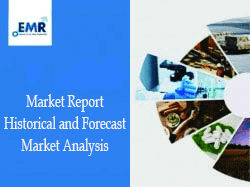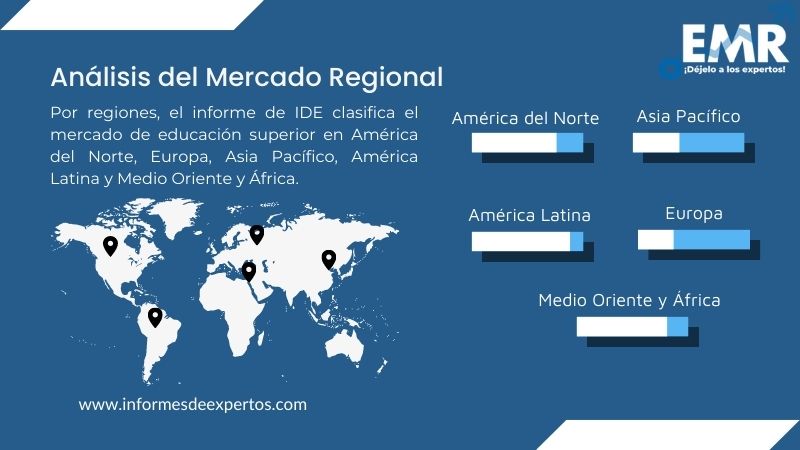Informes

Mercado Global de Educación Superior – Por Componente (Solución, Servicios); Por Tipo de Despliegue (En las Instalaciones, Nube); Por Tipo de Curso (Artes, Economía, Ingeniería, Derecho, Ciencias, Otros); Por Vertical (Universidades Estatales, Públicas, Privadas); Por Región (América del Norte, Europa, Asia Pacífico, América Latina, Medio Oriente y África); Dinámica del Mercado (2025-2034) y Panorama Competitivo
Visión General del Mercado de Educación Superior
El mercado de educación superior alcanzó un valor de USD 15,72 mil millones en el año 2024. Se estima que el mercado crecerá a una tasa de crecimiento anual compuesta del 8,4% entre 2025 y 2034, para alcanzar un valor de 32,48 mil millones de USD en 2034.

La educación superior es un término utilizado para describir los programas educativos y las oportunidades de aprendizaje que van más allá de la escuela secundaria o el bachillerato. Abarca la educación formal y la formación impartida por institutos, universidades y otras instituciones postsecundarias. La educación superior se centra en el desarrollo de conocimientos avanzados y habilidades en campos específicos de estudio o profesiones, que conducen a credenciales reconocidas como títulos, diplomas y certificados.
La mayor cuota del mercado de educación superior corresponde a las universidades estatales y las privadas esperan un crecimiento significativo. Por otra parte, es probable que las universidades públicas experimenten un crecimiento lento debido al descenso del número de matriculaciones. Una tendencia al alza en la educación es el aprendizaje basado en competencias, en el que se enseña a los estudiantes habilidades prácticas para el mercado laboral. Cada vez más instituciones ofrecen estos programas, ya que los empresarios buscan candidatos con estas habilidades específicas.
La región norteamericana posee la mayor cuota de mercado de educación superior, especialmente Estados Unidos, seguida de cerca por Europa y Asia, ya que son actores destacados del sector. Estados Unidos es famoso por su educación de calidad y su variado sistema de enseñanza superior, mientras que Europa es conocida por su excelencia en investigación e innovación, especialmente en ciencia, ingeniería y tecnología. Mientras tanto, Asia está emergiendo rápidamente en el sector e invirtiendo mucho en su sistema de enseñanza superior, sobre todo en investigación y desarrollo, atrayendo a más estudiantes internacionales.
Factores Importantes que Florecen al Mercado de Educación Superior
- Demografía: El tamaño y la edad de la población desempeñan un papel crucial a la hora de determinar la demanda de educación superior. A medida que la población crece, también lo hace la demanda de educación, y a medida que la población envejece, más personas pueden estar interesadas en cursar estudios superiores para avanzar en sus carreras.
- Avances tecnológicos: Los avances tecnológicos han transformado la impartición y el consumo de la educación. La aparición de plataformas de aprendizaje en línea, aulas virtuales y otras tecnologías ha hecho que la educación sea más accesible y cómoda para los estudiantes. En consecuencia, las instituciones que ofrecen opciones de aprendizaje flexibles y basadas en la tecnología tienden a atraer y retener a los estudiantes de manera más eficiente.
- Condiciones económicas: Las condiciones económicas pueden afectar significativamente al mercado de la enseñanza superior. En tiempos de incertidumbre económica, la gente puede sentirse más inclinada a cursar estudios superiores para mejorar sus perspectivas laborales. Además, los cambios en la financiación gubernamental de la educación y las fluctuaciones en los precios de las matrículas pueden afectar al tamaño del mercado de educación superior.
- Globalización: La creciente globalización de la economía mundial ha hecho que la educación sea más crucial que nunca. A medida que el mundo se vuelve más interconectado, más personas buscan educación para obtener una ventaja competitiva en el mercado laboral. Esto ha provocado un aumento de la demanda de educación superior, sobre todo en campos como los negocios, la ingeniería y la tecnología.
Educación Superior: Análisis del Mercado

Por componentes, el mercado se divide en:
- Solución
- Servicios
Según el tipo de despliegue, el sector se divide en:
- En las Instalaciones
- Nube
Por tipo de curso, el mercado se segmenta en:
- Artes
- Economía
- Ingeniería
- Derecho
- Ciencias
- Otros
Sobre la base de vertical, la industria demuestra varios segmentos tales como:
- Universidades Estatales
- Universidades Públicas
- Universidades Privadas
Por regiones, el informe de IDE clasifica el mercado de educación superior en América del Norte, Europa, Asia Pacífico, América Latina y Medio Oriente y África.

Panorama Competitivo
Cabe señalar que el mercado de educación superior es muy competitivo, con muchas marcas importantes compitiendo por el dominio en varias regiones. Otros factores, como condiciones económicas favorables y avances tecnológicos, también pueden influir en el crecimiento y el dominio de determinadas regiones en el mercado en el futuro. Las principales empresas estudiadas en el informe son:
- Anthology Inc.
- Blackbaud, Inc.
- Google LLC
- Microsoft Corporation
- Ellucian Company L.P
- Oracle Corporation
- IBM Corporation
- SAP SE
- Pearson plc
- Dell, Inc
- VMware, Inc
- Xerox Holdings Corporation
- ServiceNow, Inc
- Unifyed
- Hyland Software
- Otros
El informe de Informes de Expertos (IDE) representa un estudio detallado del mercado global de educación superior con referencia a los patrones de crecimiento significativos durante los períodos pronóstico (2025-2034) e histórico (2018-2024). Sobre la base de segmentos que incluyen componente, tipo de despliegue, tipo de curso, vertical, y áreas geográficas clave, el mercado se analiza e investiga a fondo. Utilizando el análisis de las cinco fuerzas de Porter y el análisis FODA, el informe muestra las amenazas de nuevos participantes, el grado de rivalidad y los poderes de proveedores y compradores.
Alcance del Mercado
|
Características del Informe |
Detalles |
|
Año Base de la Estimación: |
2024 |
|
Datos Históricos: |
2018-2024 |
|
Datos de Pronóstico: |
2025-2034 |
|
Alcance del Informe: |
Tendencias Históricas y Previsiones del Mercado, Impulsores y Limitantes de
|
|
Desglose por Componente: |
|
|
Desglose por |
|
|
Desglose por |
|
|
Desglose por Vertical: |
|
|
Desglose por Región: |
|
|
Dinámica del Mercado: |
|
|
Panorama Competitivo: |
|
|
Empresas Cubrietas: |
|
*En Informes de Expertos siempre nos esforzamos por brindarle la información más reciente. Los números de artículo son solo indicativos y pueden diferir del informe real.
Language of the Report – English
Sin embargo, el informe puede estar disponible en español por un costo adicional.
1 Preface
2 Report Coverage – Key Segmentation and Scope
3 Report Description
3.1 Market Definition and Outlook
3.2 Properties and Applications
3.3 Market Analysis
3.4 Key Players
4 Key Assumptions
5 Executive Summary
5.1 Overview
5.2 Key Drivers
5.3 Key Developments
5.4 Competitive Structure
5.5 Key Industrial Trends
6 Market Snapshot
6.1 Global
6.2 Regional
7 Opportunities and Challenges in the Market
8 Global Higher Education Market Analysis
8.1 Key Industry Highlights
8.2 Global Higher Education Historical Market (2018-2024)
8.3 Global Higher Education Market Forecast (2025-2034)
8.4 Global Higher Education Market by Component
8.4.1 Solution
8.4.1.1 Historical Trend (2018-2024)
8.4.1.2 Forecast Trend (2025-2034)
8.4.2 Services
8.4.2.1 Historical Trend (2018-2024)
8.4.2.2 Forecast Trend (2025-2034)
8.5 Global Higher Education Market by Deployment Type
8.5.1 On-Premises
8.5.1.1 Historical Trend (2018-2024)
8.5.1.2 Forecast Trend (2025-2034)
8.5.2 Cloud
8.5.2.1 Historical Trend (2018-2024)
8.5.2.2 Forecast Trend (2025-2034)
8.6 Global Higher Education Market by Course Type
8.6.1 Arts
8.6.1.1 Historical Trend (2018-2024)
8.6.1.2 Forecast Trend (2025-2034)
8.6.2 Economics
8.6.2.1 Historical Trend (2018-2024)
8.6.2.2 Forecast Trend (2025-2034)
8.6.3 Engineering
8.6.3.1 Historical Trend (2018-2024)
8.6.3.2 Forecast Trend (2025-2034)
8.6.4 Law
8.6.4.1 Historical Trend (2018-2024)
8.6.4.2 Forecast Trend (2025-2034)
8.6.5 Science
8.6.5.1 Historical Trend (2018-2024)
8.6.5.2 Forecast Trend (2025-2034)
8.6.6 Others
8.7 Global Higher Education Market by Vertical
8.7.1 State Universities
8.7.1.1 Historical Trend (2018-2024)
8.7.1.2 Forecast Trend (2025-2034)
8.7.2 Community Colleges
8.7.2.1 Historical Trend (2018-2024)
8.7.2.2 Forecast Trend (2025-2034)
8.7.3 Private Colleges
8.7.3.1 Historical Trend (2018-2024)
8.7.3.2 Forecast Trend (2025-2034)
8.8 Global Higher Education Market by Region
8.8.1 North America
8.8.1.1 Historical Trend (2018-2024)
8.8.1.2 Forecast Trend (2025-2034)
8.8.2 Europe
8.8.2.1 Historical Trend (2018-2024)
8.8.2.2 Forecast Trend (2025-2034)
8.8.3 Asia Pacific
8.8.3.1 Historical Trend (2018-2024)
8.8.3.2 Forecast Trend (2025-2034)
8.8.4 Latin America
8.8.4.1 Historical Trend (2018-2024)
8.8.4.2 Forecast Trend (2025-2034)
8.8.5 Middle East and Africa
8.8.5.1 Historical Trend (2018-2024)
8.8.5.2 Forecast Trend (2025-2034)
9 North America Higher Education Market Analysis
9.1 Market by Component
9.2 Market by Deployment Type
9.3 Market by Course Type
9.4 Market by Vertical
9.5 Market by Country
9.5.1 United States of America
9.5.1.1 Historical Trend (2018-2024)
9.5.1.2 Forecast Trend (2025-2034)
9.5.2 Canada
9.5.2.1 Historical Trend (2018-2024)
9.5.2.2 Forecast Trend (2025-2034)
10 Europe Higher Education Market Analysis
10.1 Market by Component
10.2 Market by Deployment Type
10.3 Market by Course Type
10.4 Market by Vertical
10.5 Market by Country
10.5.1 United Kingdom
10.5.1.1 Historical Trend (2018-2024)
10.5.1.2 Forecast Trend (2025-2034)
10.5.2 Germany
10.5.2.1 Historical Trend (2018-2024)
10.5.2.2 Forecast Trend (2025-2034)
10.5.3 France
10.5.3.1 Historical Trend (2018-2024)
10.5.3.2 Forecast Trend (2025-2034)
10.5.4 Italy
10.5.4.1 Historical Trend (2018-2024)
10.5.4.2 Forecast Trend (2025-2034)
10.5.5 Others
11 Asia Pacific Higher Education Market Analysis
11.1 Market by Component
11.2 Market by Deployment Type
11.3 Market by Course Type
11.4 Market by Vertical
11.5 Market by Country
11.5.1 China
11.5.1.1 Historical Trend (2018-2024)
11.5.1.2 Forecast Trend (2025-2034)
11.5.2 Japan
11.5.2.1 Historical Trend (2018-2024)
11.5.2.2 Forecast Trend (2025-2034)
11.5.3 India
11.5.3.1 Historical Trend (2018-2024)
11.5.3.2 Forecast Trend (2025-2034)
11.5.4 ASEAN
11.5.4.1 Historical Trend (2018-2024)
11.5.4.2 Forecast Trend (2025-2034)
11.5.5 South Korea
11.5.5.1 Historical Trend (2018-2024)
11.5.5.2 Forecast Trend (2025-2034)
11.5.6 Australia
11.5.6.1 Historical Trend (2018-2024)
11.5.6.2 Forecast Trend (2025-2034)
11.5.7 Others
12 Latin America Higher Education Market Analysis
12.1 Market by Component
12.2 Market by Deployment Type
12.3 Market by Course Type
12.4 Market by Vertical
12.5 Market by Country
12.5.1 Brazil
12.5.1.1 Historical Trend (2018-2024)
12.5.1.2 Forecast Trend (2025-2034)
12.5.2 Argentina
12.5.2.1 Historical Trend (2018-2024)
12.5.2.2 Forecast Trend (2025-2034)
12.5.3 Mexico
12.5.3.1 Historical Trend (2018-2024)
12.5.3.2 Forecast Trend (2025-2034)
12.5.4 Others
13 Middle East and Africa Higher Education Market Analysis
13.1 Market by Component
13.2 Market by Deployment Type
13.3 Market by Course Type
13.4 Market by Vertical
13.5 Market by Country
13.5.1 Saudi Arabia
13.5.1.1 Historical Trend (2018-2024)
13.5.1.2 Forecast Trend (2025-2034)
13.5.2 United Arab Emirates
13.5.2.1 Historical Trend (2018-2024)
13.5.2.2 Forecast Trend (2025-2034)
13.5.3 Nigeria
13.5.3.1 Historical Trend (2018-2024)
13.5.3.2 Forecast Trend (2025-2034)
13.5.4 South Africa
13.5.4.1 Historical Trend (2018-2024)
13.5.4.2 Forecast Trend (2025-2034)
13.5.5 Others
14 Market Dynamics
14.1 SWOT Analysis
14.1.1 Strengths
14.1.2 Weaknesses
14.1.3 Opportunities
14.1.4 Threats
14.2 Porter’s Five Forces Analysis
14.2.1 Supplier’s Power
14.2.2 Buyer’s Power
14.2.3 Threat of New Entrants
14.2.4 Degree of Rivalry
14.2.5 Threat of Substitutes
14.3 Key Indicators for Demand
14.4 Key Indicators for Price
15 Competitive Landscape
15.1 Market Structure
15.2 Company Profiles
15.2.1 Anthology Inc.
15.2.1.1 Company Overview
15.2.1.2 Product Portfolio
15.2.1.3 Demographic Reach and Achievements
15.2.1.4 Certifications
15.2.2 Blackbaud, Inc.
15.2.2.1 Company Overview
15.2.2.2 Product Portfolio
15.2.2.3 Demographic Reach and Achievements
15.2.2.4 Certifications
15.2.3 Google LLC
15.2.3.1 Company Overview
15.2.3.2 Product Portfolio
15.2.3.3 Demographic Reach and Achievements
15.2.3.4 Certifications
15.2.4 Microsoft Corporation
15.2.4.1 Company Overview
15.2.4.2 Product Portfolio
15.2.4.3 Demographic Reach and Achievements
15.2.4.4 Certifications
15.2.5 Ellucian Company L.P
15.2.5.1 Company Overview
15.2.5.2 Product Portfolio
15.2.5.3 Demographic Reach and Achievements
15.2.5.4 Certifications
15.2.6 Oracle Corporation
15.2.6.1 Company Overview
15.2.6.2 Product Portfolio
15.2.6.3 Demographic Reach and Achievements
15.2.6.4 Certifications
15.2.7 IBM Corporation
15.2.7.1 Company Overview
15.2.7.2 Product Portfolio
15.2.7.3 Demographic Reach and Achievements
15.2.7.4 Certifications
15.2.8 SAP SE
15.2.8.1 Company Overview
15.2.8.2 Product Portfolio
15.2.8.3 Demographic Reach and Achievements
15.2.8.4 Certifications
15.2.9 Pearson plc
15.2.9.1 Company Overview
15.2.9.2 Product Portfolio
15.2.9.3 Demographic Reach and Achievements
15.2.9.4 Certifications
15.2.10 Dell, Inc
15.2.10.1 Company Overview
15.2.10.2 Product Portfolio
15.2.10.3 Demographic Reach and Achievements
15.2.10.4 Certifications
15.2.11 VMware, Inc
15.2.11.1 Company Overview
15.2.11.2 Product Portfolio
15.2.11.3 Demographic Reach and Achievements
15.2.11.4 Certifications
15.2.12 Xerox Holdings Corporation
15.2.12.1 Company Overview
15.2.12.2 Product Portfolio
15.2.12.3 Demographic Reach and Achievements
15.2.12.4 Certifications
15.2.13 ServiceNow, Inc
15.2.13.1 Company Overview
15.2.13.2 Product Portfolio
15.2.13.3 Demographic Reach and Achievements
15.2.13.4 Certifications
15.2.14 Unifyed
15.2.14.1 Company Overview
15.2.14.2 Product Portfolio
15.2.14.3 Demographic Reach and Achievements
15.2.14.4 Certifications
15.2.15 Hyland Software
15.2.15.1 Company Overview
15.2.15.2 Product Portfolio
15.2.15.3 Demographic Reach and Achievements
15.2.15.4 Certifications
15.2.16 Others
16 Key Trends and Developments in the Market
List of Key Figures and Tables
1. Global Higher Education Market: Key Industry Highlights, 2018 and 2034
2. Global Higher Education Historical Market: Breakup by Component (USD Million), 2018-2024
3. Global Higher Education Market Forecast: Breakup by Component (USD Million), 2025-2034
4. Global Higher Education Historical Market: Breakup by Deployment Type (USD Million), 2018-2024
5. Global Higher Education Market Forecast: Breakup by Deployment Type (USD Million), 2025-2034
6. Global Higher Education Historical Market: Breakup by Course Type (USD Million), 2018-2024
7. Global Higher Education Market Forecast: Breakup by Course Type (USD Million), 2025-2034
8. Global Higher Education Historical Market: Breakup by Vertical (USD Million), 2018-2024
9. Global Higher Education Market Forecast: Breakup by Vertical (USD Million), 2025-2034
10. Global Higher Education Historical Market: Breakup by Region (USD Million), 2018-2024
11. Global Higher Education Market Forecast: Breakup by Region (USD Million), 2025-2034
12. North America Higher Education Historical Market: Breakup by Country (USD Million), 2018-2024
13. North America Higher Education Market Forecast: Breakup by Country (USD Million), 2025-2034
14. Europe Higher Education Historical Market: Breakup by Country (USD Million), 2018-2024
15. Europe Higher Education Market Forecast: Breakup by Country (USD Million), 2025-2034
16. Asia Pacific Higher Education Historical Market: Breakup by Country (USD Million), 2018-2024
17. Asia Pacific Higher Education Market Forecast: Breakup by Country (USD Million), 2025-2034
18. Latin America Higher Education Historical Market: Breakup by Country (USD Million), 2018-2024
19. Latin America Higher Education Market Forecast: Breakup by Country (USD Million), 2025-2034
20. Middle East and Africa Higher Education Historical Market: Breakup by Country (USD Million), 2018-2024
21. Middle East and Africa Higher Education Market Forecast: Breakup by Country (USD Million), 2025-2034
22. Global Higher Education Market Structure
*The list of players in the competitive landscape section can be customised or made more exhaustive based on your specific requirements.*
Durante el periodo de pronóstico de 2025-2034, se espera que el mercado de educación superior crezca a una CAGR del 8,4%.
En 2024, el tamaño del mercado de educación superior fue de 15,72 mil millones de dólares.
La demanda de los estudiantes, la oferta de las instituciones y las políticas gubernamentales configuran el mercado de educación superior.
Mayor atención al aprendizaje en línea e híbrido, aumento de los costes de las matrículas y creciente énfasis en la preparación profesional y el desarrollo de la mano de obra en educación superior.
Los dos mayores componentes son solución y servicios.
En las instalaciones y nube son los comunes tipos de despliegue.
Los tipos de curso incluyen artes, economía, ingeniería, derecho, ciencias, y otros.
Por vertical, el mercado se divide en universidades estatales, públicas, y privadas.
Las importantes empresas son Anthology Inc., Blackbaud, Inc., Google LLC, Microsoft Corporation, Ellucian Company L.P, Oracle Corporation, IBM Corporation, SAP SE, Pearson plc, Dell, Inc, VMware, Inc, Xerox Holdings Corporation, ServiceNow, Inc, Unifyed, Hyland Software, y otros.
Las mejores regiones en el mercado son América del Norte, Europa, Asia Pacífico, América Latina y Medio Oriente y África.
Se estima que el mercado de educación superior registrará un fuerte crecimiento durante el periodo de pronóstico de 2025-2034 para alcanzar los 32,48 mil millones de USD en 2034.
Excel Data Set
-
Datos completos en formato Excel para un usuario
-
Impresión no permitida
-
Entrega por Email
-
Personalización limitada gratuita (pre-venta)Soporte de analista post ventaDescuento del 50% en la Próxima ActualizaciónUsuario Único
USD3199USD2999-
Restringido a un usuario
-
Solo una impresión
-
Disponible en PDF
-
Personalización limitada gratuita (pre-venta)Soporte de analista post ventaDescuento del 50% en la Próxima ActualizaciónCinco Usuarios
USD4199USD3999-
Restringido a cinco usuarios
-
Una impresión por usuario
-
Disponible en PDF
-
Personalización limitada gratuita (pre-venta)
-
Soporte de analista post venta
-
Descuento del 50% en la Próxima Actualización
Multiusuario
USD5199USD4999-
Usuarios ilimitados dentro de la organización
-
Impresiones ilimitadas
-
Disponible en PDF
-
Personalización limitada gratuita (pre-venta)
-
Soporte de analista post venta
-
Descuento del 50% en la Próxima Actualización
Póngase en Contacto¿Cualquier Pregunta? Hable con un Analista
Solicitar una MuestraVer una Muestra
Solicitar PersonalizaciónSe le olvidó algo? Pregunte Ahora
¿Por qué Informes de Expertos?La Gente Adecuada
Somos técnicamente excelentes, estratégicos, prácticos, experimentados y eficientes; nuestros analistas son cuidadosamente seleccionados en función de tener los atributos correctos para trabajar con éxito y ejecutar proyectos basados en sus expectativas.
Metodología Correcta
Aprovechamos nuestra tecnología de vanguardia, nuestro acceso a bases de datos confiables y nuestro conocimiento de los modelos actuales utilizados en el mercado para ofrecerle soluciones de investigación que se adapten a sus necesidades y lo pongan a la vanguardia.
Precio Justo
Realizamos una investigación exhaustiva y de calidad superior a precios razonables, inigualables y que demuestran nuestra comprensión de su estructura de recursos. Además, ofrecemos descuentos atractivos en nuestros próximos informes.
Apoyo Adecuado
Nuestro equipo de analistas expertos está a su disposición entera para ofrecerle resultados óptimos personalizados para satisfacer sus necesidades precisas dentro del plazo especificado y ayudarlo a comprender mejor la industria.
Informes SimilaresEl mercado latinoamericano de servicios de catering está experimentando un enorme crecimiento debido a la rápida urbanización, el creciente número de eventos sociales en la región y la creciente ...
El mercado de aprendizaje electrónico de América Latina está experimentando un crecimiento significativo debido a la rápida digitalización, la creciente popularidad de los modelos híbridos de ap...
El desarrollo del mercado global de servicios de entrega de alimentos se está acelerando debido a varios factores, entre ellos la creciente adopción de teléfonos inteligentes, la creciente preferen...
El mercado de distribución alimentaria está experimentando un enorme crecimiento debido a la creciente demanda de platos preparados, el aumento de los ingresos disponibles, los cambios en los hábit...
El mercado de spa está experimentando un crecimiento significativo debido a la creciente conciencia de los consumidores sobre la salud, el aumento de los ingresos disponibles y el incremento del gast...
Newsletter





